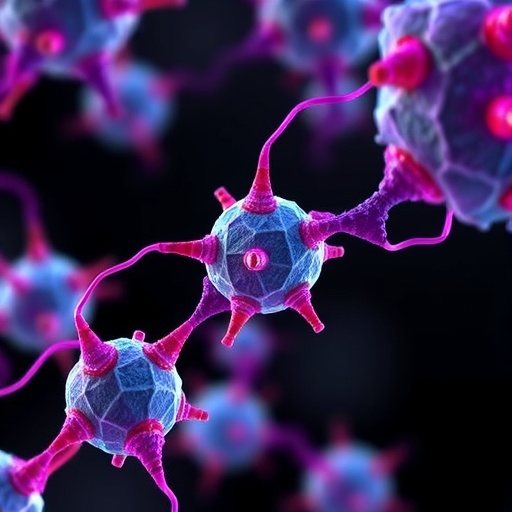In the relentless battle against cancer, one of the most formidable obstacles remains the ability of malignant cells to evade the effects of chemotherapy, leading to disease relapse and poor patient outcomes. Acute myeloid leukemia (AML), a highly aggressive form of blood cancer accounting for approximately 80% of adult acute leukemia cases, epitomizes this challenge due to its notorious capacity for recurrence after initial treatment success. Recent groundbreaking research spearheaded by scientists at The Jackson Laboratory (JAX) has illuminated a previously elusive molecular mechanism that underpins this chemoresistance, pointing to promising new therapeutic avenues that could transform AML patient care.
At the heart of this research lies a specific protein isoform, RUNX1C, which is a variant product of the RUNX1 gene, known to be a critical regulator of normal blood cell differentiation and function. This isoform had been relatively understudied, but the JAX team, led by assistant professor Eric Wang, has uncovered its pivotal role in enabling AML cells to withstand chemotherapy and enter a protective dormant state. The study, published in the prestigious journal Blood Cancer Discovery, underscores a sophisticated regulatory axis involving RUNX1C and a downstream gene, BTG2, which together orchestrate the quiescence and survival of leukemia cells in the face of genotoxic stress from chemotherapeutic agents.
The investigation employed a comprehensive analysis of patient-derived data, examining samples taken before chemotherapy and after AML relapse. Remarkably, the researchers identified a pronounced increase in DNA methylation—a chemical modification that generally suppresses gene expression—in a genomic region controlling RUNX1. This epigenetic switch led to enhanced production of the RUNX1C isoform specifically, rather than a general increase in RUNX1 expression. This precision epigenetic alteration is critical because it activates a cascade of molecular events that skew the leukemia cells toward chemoresistance.
Delving deeper into mechanism, it was revealed that RUNX1C upregulates the BTG2 gene. BTG2 functions as a cell cycle regulator by interfering with RNA activity, effectively dampening cellular proliferation signals. The consequence is a shift in leukemia cells to enter a quiescent or dormant state, wherein they cease dividing and thus evade the cytotoxic effects of chemotherapy, which preferentially targets rapidly dividing cells. This cellular dormancy effectively cloaks the cancer cells from therapeutic elimination, allowing them to persist silently and ultimately rekindle disease when treatment ceases.
Wang emphasizes the clinical implications of these findings, noting the scarcity of effective treatments for AML patients who relapse following standard chemotherapy regimens. This research not only elucidates the molecular underpinnings of relapse but also identifies RUNX1C as a strategically viable target for therapeutic intervention. Importantly, the team demonstrated that experimentally inhibiting RUNX1C in AML cellular models and mouse systems significantly lowered chemoresistance, as cancer cells were forced out of quiescence, becoming once again vulnerable to chemotherapeutic drugs.
Central to this innovative approach is the application of antisense oligonucleotides (ASOs), sophisticated RNA-targeting molecules capable of binding to specific RNA transcripts and blocking protein production. While ASO technology has seen success in rare neurological disorders, its use in AML and other cancers remains largely unexplored. The promising results from Wang’s lab suggest that ASOs engineered specifically to suppress RUNX1C expression could restore chemotherapy sensitivity by preventing leukemia cells from entering dormancy, offering a potent combination strategy alongside conventional treatments.
The functional experiments conducted by Dr. Cuijuan Han, the study’s lead author, further validated the causative role of RUNX1C in chemoresistance. Overexpression of RUNX1C rendered AML cells resistant to multiple chemotherapeutic drugs, while genetic silencing of this isoform sensitized cells, underscoring a direct link between RUNX1C abundance and therapy outcomes. These meticulously executed gain- and loss-of-function studies highlight the isoform-specific nature of chemoresistance mechanisms, an aspect previously overlooked in AML research.
This work also serves as an important proof of concept that RNA isoforms—which arise from alternative processing of the same gene transcript—are not mere biological noise but critical regulators of cancer cell behavior. Such isoform-specific targeting may revolutionize the understanding and treatment of not only AML but potentially a broad spectrum of cancers. Wang notes the potential to extend these insights, proposing future research to explore isoform modulation across different malignancies and therapeutic contexts.
Beyond its immediate translational potential, this research adds a novel layer to the complex understanding of cancer biology. The epigenetic regulation of gene isoforms introduces a nuanced dimension to how leukemic cells adapt to and resist chemotherapeutic pressure. It shifts the paradigm from focusing solely on gene-level expression changes to appreciating the diversity of RNA isoforms driving disease progression. This enhanced comprehension could inform biomarker development and therapeutic design, optimizing individualized treatment strategies.
The Jackson Laboratory team plans to continue refining RNA-targeting technologies to enhance specificity and efficacy in vivo, as well as to investigate combinational therapies pairing ASOs with emerging targeted agents. They envision that the tailored inhibition of RUNX1C could be integrated into multi-modal treatment regimens, improving remission durability and ultimately patient survival. Given the high relapse rate and dismal prognosis for relapsed AML patients, such advancements could markedly shift clinical outcomes.
In conclusion, the JAX study illuminates a transformative avenue in cancer therapeutics by pinpointing an isoform-specific pathway that governs leukemia cell dormancy and chemoresistance. Through the innovative use of RNA-targeting antisense technology, there is newfound hope for overcoming one of the most stubborn hurdles in AML treatment. This research not only enhances fundamental cancer biology knowledge but also foreshadows the arrival of precision molecular interventions capable of disabling the stealth tactics employed by lethal cancers.
Subject of Research: Animals
Article Title: An Isoform-Specific RUNX1C–BTG2 Axis Governs AML Quiescence and Chemoresistance
News Publication Date: 11-Aug-2025
Web References:
- https://aacrjournals.org/bloodcancerdiscov/article/doi/10.1158/2643-3230.BCD-24-0327/764069/An-Isoform-Specific-RUNX1C-BTG2-Axis-Governs-AML
- http://dx.doi.org/10.1158/2643-3230.BCD-24-0327
References:
Wang, E., Han, C., et al. An Isoform-Specific RUNX1C–BTG2 Axis Governs AML Quiescence and Chemoresistance. Blood Cancer Discovery. 11 August 2025.
Image Credits: The Jackson Laboratory
Keywords: Leukemia, Myeloid leukemia, RNA




